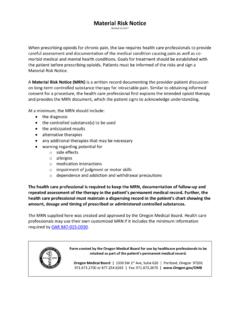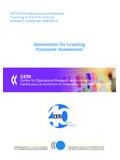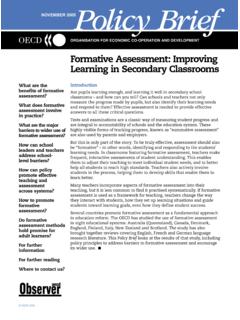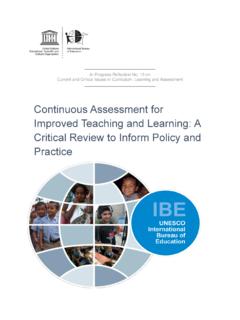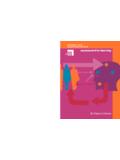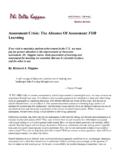Transcription of Writing Tips for Learning Goals and Success Criteria ...
1 1 This work is offered under a Creative CommonsAttribution-NonCommercial-ShareAl ike International LicenseWriting Tips for Learning Goals and Success CriteriaActivity you are Writing them, remember: Learning Goals should refer to understanding, knowledge, skills, or application. Success Criteria should refer to a concrete Learning performance: something students will say, do, make, or write to indicate they are moving toward the Learning Success Criteria are aligned to a particular Learning Goal, thinking of them on their own (without the Learning Goal they belong to ) does not make a lot of sense.
2 This relationship between the two ( Success Criteria refer to and depend on a Learning Goal) means that Learning Goals need to be written first, before Success Goals often begin with verbs like know, develop, become fluent, apply, understand, use, or extend. Success Criteria often begin with verbs like explain, describe, model, show, write, justify, or create. Some examples of Learning Goals and Success Criteria are: Learning GoalSuccess CriteriaUnderstand how the structure of DNA relates to its functionDefine the terms structure and function; describe the structure of DNA; explain why the base pair rule means DNA forms complementary strands and a double helixUse what you know about reading strategies so that you can understand what the text says as you readUse what you know about sounds and letters; ask yourself if the language makes sense; think about what you already know about the topic.
3 Use context clues when you come to a word you do not knowKnow how advertisers use persuasive techniques in multi-modal advertisementsDescribe how soft and hard sells are conveyed; explain the positive and negative emotions an advertisement aims to provoke; describe what makes an advertisement particularly effective and/or persuasiveRepresent and solve addition and subtraction word problems by using different representationsExplain what each number in the problem means; explain why you chose to add or subtract; explain how your representation shows adding or subtractingUse the Goals specify the Learning that is intended for a lesson, and Success Criteria indicate how students can demonstrate that attention to your choice of Writing Learning Goals and Success Criteria , it can be helpful to focus on selecting the right verb, which is often the first word of the sentence.
4 2 This work is offered under a Creative CommonsAttribution-NonCommercial-ShareAl ike International LicenseWhile Learning Goals and Learning Experiences are related, they are fundamentally different components of formative assessment, and it is essential to distinguish between them. A Learning Goal comes before a Learning experience; it is, in fact, the reason for the Learning Experience. What this means for lesson planning is that the Learning Goal is established first, so that it can orient the design of aligned Learning Experiences. Put simply, the question, "What will my students be doing?
5 " should only be asked when there is a clear answer to the question, "Why will they be doing it?" Below are examples of Learning Goals and Learning Experiences. Because the Learning Goals are substantive, students will need many more than the one Learning Experience shown to meet the GoalLearning ExperienceUnderstand the chronicle of events that led up to the internment of Japanese-Americans in1942 and the causal relationships among these eventsCreate a timeline of the events leading up to the history of Japanese-American Internment Understand how authors use archetypes to help us quickly recognize charactersRead two texts and identify which author uses an archetype and which author uses a stereotype Use graphical representations to analyze exponential
6 FunctionsExplore what happens to the graph of the function, f(x) = ax when the value of a changesLearning Goals are not Learning Goals describe what students are going to learn, whereas Learning Experiences describe how students are going to acquire that Learning ( , what they are going to do in order to move towards the Learning Goal). It is important to remember, however, that Learning Goals are part of a much more extensive progression of Learning that builds from Learning Goals , through Building Blocks, all the way to standards. Even though Learning Goals are lesson-sized, they are not isolated or discrete: the Learning they describe is aligned to a standard and connected to other prior, concurrent, and future Learning .
7 Learning Goals are Goals describe an amount of Learning that is manageable in the context of a lesson (which might be 2 or 3 class periods). 3 This work is offered under a Creative CommonsAttribution-NonCommercial-ShareAl ike International LicenseAccessible Learning Goals and Success Criteria enables students to participate in and contribute to the Learning community by evaluating their own and their peers Learning . When students internalize Learning Goals and Success Criteria , this also helps them make meaning of challenging content. A clear sense of what the goal is and what it will look like as they move towards that goal can act like a cognitive lighthouse, a feature of the cognitive landscape with which students can organize and orient their Learning Goals and Success Criteria accessible to Goals and Success Criteria , which are critical componentsof peer and self-assessment, should be expressed in language that students can understand and Goals might be invisible because they often happen inside a student s head you cannot directly observe things like knowing or understanding.
8 This is why Success Criteria should always be written as performances of Learning that you can actually observe, things students will say, do, make, or write that will make the status of their Learning visible. Make sure Success Criteria are happens inside a student's head, but Success Criteria help make that Learning visible.









